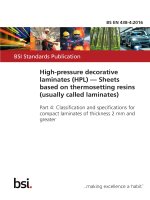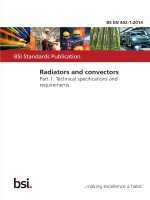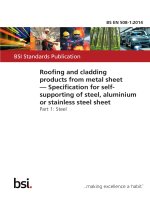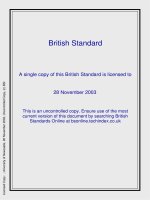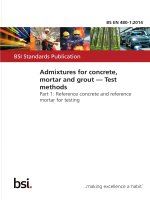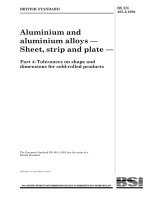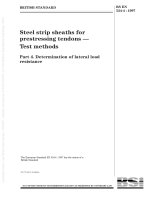Bsi bs en 15534 4 2014
Bạn đang xem bản rút gọn của tài liệu. Xem và tải ngay bản đầy đủ của tài liệu tại đây (1.07 MB, 18 trang )
BS EN 15534-4:2014
BSI Standards Publication
Composites made from
cellulose-based materials and
thermoplastics (usually called
wood-polymer composites
(WPC) or natural fibre
composites (NFC))
Part 4: Specifications for decking profiles
and tiles
BS EN 15534-4:2014
BRITISH STANDARD
National foreword
This British Standard is the UK implementation of EN 15534-4:2014.
Together with BS EN 15534-5:2014 it supersedes DD CEN/TS
15534-3:2007, which is withdrawn.
The UK participation in its preparation was entrusted to Technical
Committee PRI/42, Fibre reinforced thermosetting plastics and
prepregs.
A list of organizations represented on this committee can be
obtained on request to its secretary.
This publication does not purport to include all the necessary
provisions of a contract. Users are responsible for its correct
application.
© The British Standards Institution 2014.
Published by BSI Standards Limited 2014
ISBN 978 0 580 79504 6
ICS 79.080; 83.140.99
Compliance with a British Standard cannot confer immunity from
legal obligations.
This British Standard was published under the authority of the
Standards Policy and Strategy Committee on 31 March 2014.
Amendments/corrigenda issued since publication
Date
Text affected
BS EN 15534-4:2014
EN 15534-4
EUROPEAN STANDARD
NORME EUROPÉENNE
EUROPÄISCHE NORM
January 2014
ICS 79.080; 83.140.99
Supersedes CEN/TS 15534-3:2007
English Version
Composites made from cellulose-based materials and
thermoplastics (usually called wood-polymer composites (WPC)
or natural fibre composites (NFC)) - Part 4: Specifications for
decking profiles and tiles
Composites à base de matières cellulosiques et de
thermoplastiques (communément appelés composites boispolymères (WPC) ou composites fibres d'origine naturelle
(NFC)) - Partie 4: Spécifications relatives aux lames et
dalles pour platelage
Verbundwerkstoffe aus cellulosehaltigen Materialien und
Thermoplasten (üblicherweise Holz-Polymer-Werkstoffe
(WPC) oder Naturfaserverbundwerkstoffe (NFC) genannt) Teil 4: Anforderungen an Profile und Formteile für
Bodenbeläge
This European Standard was approved by CEN on 9 November 2013.
CEN members are bound to comply with the CEN/CENELEC Internal Regulations which stipulate the conditions for giving this European
Standard the status of a national standard without any alteration. Up-to-date lists and bibliographical references concerning such national
standards may be obtained on application to the CEN-CENELEC Management Centre or to any CEN member.
This European Standard exists in three official versions (English, French, German). A version in any other language made by translation
under the responsibility of a CEN member into its own language and notified to the CEN-CENELEC Management Centre has the same
status as the official versions.
CEN members are the national standards bodies of Austria, Belgium, Bulgaria, Croatia, Cyprus, Czech Republic, Denmark, Estonia,
Finland, Former Yugoslav Republic of Macedonia, France, Germany, Greece, Hungary, Iceland, Ireland, Italy, Latvia, Lithuania,
Luxembourg, Malta, Netherlands, Norway, Poland, Portugal, Romania, Slovakia, Slovenia, Spain, Sweden, Switzerland, Turkey and United
Kingdom.
EUROPEAN COMMITTEE FOR STANDARDIZATION
COMITÉ EUROPÉEN DE NORMALISATION
EUROPÄISCHES KOMITEE FÜR NORMUNG
CEN-CENELEC Management Centre: Avenue Marnix 17, B-1000 Brussels
© 2014 CEN
All rights of exploitation in any form and by any means reserved
worldwide for CEN national Members.
Ref. No. EN 15534-4:2014 E
BS EN 15534-4:2014
EN 15534-4:2014 (E)
Contents
Page
Foreword ..............................................................................................................................................................3
1
Scope ......................................................................................................................................................5
2
Normative references ............................................................................................................................5
3
Terms and definitions ...........................................................................................................................5
4
4.1
4.2
4.3
4.4
4.5
4.5.1
4.5.2
4.5.3
4.5.4
4.5.5
4.5.6
4.5.7
Requirements .........................................................................................................................................5
General ....................................................................................................................................................5
Material ...................................................................................................................................................6
Appearance ............................................................................................................................................6
Physical characteristics ........................................................................................................................6
Mechanical characteristics ...................................................................................................................7
Falling mass impact resistance............................................................................................................7
Flexural properties.................................................................................................................................8
Creep behaviour.....................................................................................................................................8
Durability of products against biological agents ...............................................................................9
Durability of the products against ageing and moisture ...................................................................9
Thermal properties ............................................................................................................................. 10
Additional characteristics .................................................................................................................. 11
5
Marking ................................................................................................................................................ 12
Annex A (informative) Minimum frequencies of testing for factory production control purposes ....... 13
Bibliography ..................................................................................................................................................... 14
2
BS EN 15534-4:2014
EN 15534-4:2014 (E)
Foreword
This document (EN 15534-4:2014) has been prepared by Technical Committee CEN/TC 249 “Plastics”, the
secretariat of which is held by NBN.
This European Standard shall be given the status of a national standard, either by publication of an identical
text or by endorsement, at the latest by July 2014, and conflicting national standards shall be withdrawn at the
latest by July 2014.
Attention is drawn to the possibility that some of the elements of this document may be the subject of patent
rights. CEN [and/or CENELEC] shall not be held responsible for identifying any or all such patent rights.
This document together with EN 15534-5:2014 supersedes CEN/TS 15534-3:2007.
The significant changes that have been made since the previous edition are the following:
—
splitting into Parts 4 and 5 of CEN/TS 15534-3:2007;
—
change of the status from Technical Specification to European Standard;
—
complete technical review of the document;
—
change of the Scope from characterization to specification of the products.
EN 15534 consists of the following parts:
—
EN 15534-1, Composites made from cellulose-based materials and thermoplastics (usually called woodpolymer composites (WPC) or natural fibre composites (NFC)) — Part 1: Test methods for
characterization of compounds and products
—
prEN 15534-2, Composites made from cellulose-based materials and thermoplastics (usually called
wood-polymer composites (WPC) or natural fibre composites (NFC)) — Part 2: Characterization of
compounds 1)
—
EN 15534-4, Composites made from cellulose-based materials and thermoplastics (usually called woodpolymer composites (WPC) or natural fibre composites (NFC)) — Part 4: Specifications for decking
profiles and tiles
—
EN 15534-5, Composites made from cellulose-based materials and thermoplastics (usually called woodpolymer composites (WPC) or natural fibre composites (NFC)) — Part 5: Specifications for cladding
profiles and tiles
—
prEN 15534-6, Composites made from cellulose-based materials and thermoplastics (usually called
wood-polymer composites (WPC) or natural fibre composites (NFC)) — Part 6: Specifications for fencing
profiles and systems1)
—
prEN 15534-7, Composites made from cellulose-based materials and thermoplastics (usually called
wood-polymer composites (WPC) or natural fibre composites (NFC)) — Part 7: Specifications for general
purpose profiles in external applications1)
1) In preparation.
3
BS EN 15534-4:2014
EN 15534-4:2014 (E)
According to the CEN-CENELEC Internal Regulations, the national standards organizations of the following
countries are bound to implement this European Standard: Austria, Belgium, Bulgaria, Croatia, Cyprus, Czech
Republic, Denmark, Estonia, Finland, Former Yugoslav Republic of Macedonia, France, Germany, Greece,
Hungary, Iceland, Ireland, Italy, Latvia, Lithuania, Luxembourg, Malta, Netherlands, Norway, Poland, Portugal,
Romania, Slovakia, Slovenia, Spain, Sweden, Switzerland, Turkey and the United Kingdom.
4
BS EN 15534-4:2014
EN 15534-4:2014 (E)
1
Scope
This European Standard specifies the characteristics of decking profiles and tiles made from cellulose-based
materials and thermoplastics, usually called wood-polymer composites (WPC) or natural fibre composites
(NFC), for external use.
This part of EN 15534 is applicable to extruded profiles but also to tiles manufactured by other plastics
processing techniques, e.g. injection moulding.
It is not applicable to kits (i.e. support rail profiles, cover strip profiles and hardware) which are out of the
scope of this part of EN 15534.
EN 15534-1 specifies the test methods relevant to this part of EN 15534.
NOTE
For editorial reasons, in EN 15534 the abbreviation “WPC” is used for “composites made from cellulose-based
materials and thermoplastics”.
2
Normative references
The following documents, in whole or in part, are normatively referenced in this document and are
indispensable for its application. For dated references, only the edition cited applies. For undated references,
the latest edition of the referenced document (including any amendments) applies.
EN 927-6, Paints and varnishes — Coating materials and coating systems for exterior wood — Part 6:
Exposure of wood coatings to artificial weathering using fluorescent UV lamps and water
EN 15534-1:2014, Composites made from cellulose-based materials and thermoplastics (usually called woodpolymer composites (WPC) or natural fibre composites (NFC)) — Part 1: Test methods for characterisation of
compounds and products
EN 16472, Plastics — Method for artificial accelerated photoageing using medium pressure mercury vapour
lamps
EN ISO 4892-2, Plastics — Methods of exposure to laboratory light sources — Part 2: Xenon-arc lamps
(ISO 4892-2)
3
Terms and definitions
For the purposes of this document, the terms and definitions given in EN 15534-1:2014 apply.
4
Requirements
4.1 General
Initial type testing shall be performed to demonstrate compliance with the requirements specified in Clause 4
of this part of EN 15534. The tests according to 4.5.7 shall be carried out if the performance is declared by the
manufacturer. Initial type testing shall be repeated, whenever a change occurs in the composition of the
product, its geometry or in the production process. In case of a minor change, only the properties which could
be influenced by this change shall be tested.
NOTE
Minimum frequencies of testing for factory production control purposes are given in Annex A.
5
BS EN 15534-4:2014
EN 15534-4:2014 (E)
4.2 Material
The base polymer, from which the material is produced, and the type and content of cellulose-based material
shall be declared by the manufacturer.
Reprocessable and/or recyclable materials may be used for manufacturing profiles and tiles provided that they
satisfy to the provisions of this part of EN 15534.
WPC materials are recyclable materials which can be treated in a material recovery process intended to save
resources while minimizing harmful emissions into air, water and soil as well as their impacts on human
health.
NOTE
A scheme for the characterization of plastics waste is given in EN 15347 [2] and guidelines for the recovery
and recycling are given in ISO 15270 [3].
4.3 Appearance
For production control purposes, the manufacturer shall compare three samples drawn at random from the
same profile/tile production batch with a control sample, under the illumination conditions defined in
EN 15534-1:2014, 6.1.
The control samples shall be stored in a dark room and renewed every six months.
If a control sample is put in contact with water, it shall be renewed immediately.
4.4 Physical characteristics
When tested in accordance with the test methods as specified in Table 1, using the parameters indicated, the
profiles/tiles, as delivered to the customer, shall have characteristics conforming to the requirements given in
Table 1.
6
BS EN 15534-4:2014
EN 15534-4:2014 (E)
Table 1 — Physical characteristics
Characteristic
Requirements
Test method
Number of test specimens
Pendulum value ≥ 36
EN 15534–1:2014, 6.4.2
5 specimens/face/direction b
Class C (≥24°)
EN 15534–1:2014, 6.4.3
1 specimen/face/direction b
c) Dynamic coefficient
of
friction
(dry
condition)
≥ 0,43
EN 15534–1:2014, 6.4.4
1 specimen/face/direction b
Linear
mass
(applicable to profiles)
Individual values ≥ 95 % declared
value by the manufacturer.
EN 15534–1:2014, 6.5
3 specimens
Slipperiness a
a) Pendulum test
OR
b) Inclination plan test
OR
The linear mass and tolerances
shall be declared by the
manufacturer.
Thickness, width and
length (applicable to
profiles)
The relevant dimensional values
and their tolerances shall be
declared by the manufacturer.
EN 15534–1:2014, 6.6.2
3 specimens
Deviation
from
straightness
(applicable to profiles)
The deviation of straightness and
its tolerance shall be declared by
the manufacturer.
EN 15534–1:2014, 6.6.3
3 specimens
Cupping
The cupping value and its
tolerance shall be declared by the
manufacturer.
EN 15534–1:2014, 6.6.4
3 specimens
a The choice of the method for assessing the slipperiness is under the responsibility of the manufacturer taking into
account the relevant national regulations according to the field of use of the profiles/tiles, if existing. The method used for
assessing the slipperiness shall be declared by the manufacturer.
b
In both directions and on both faces of the profile/tile, if relevant.
4.5 Mechanical characteristics
4.5.1
Falling mass impact resistance
When tested in accordance with the test methods as specified in Table 2, using the parameters indicated, the
profiles/tiles, as delivered to the customer, shall have characteristic conforming to the requirements given in
Table 2.
7
BS EN 15534-4:2014
EN 15534-4:2014 (E)
Table 2 — Falling mass impact resistance
Requirements
Test parameters
Test method
Number of test
specimens
Hollow profiles
None of 10 test specimens shall show a
failure with a crack length ≥ 10 mm or a
depth of residual indentation ≥ 0,5 mm.
H: (700 ± 5) mm
Ms: (1 000 ± 5) g
EN 15534–1:2014,
7.1.2.1
10 specimens/facea
EN 15534–1:2014,
7.1.2.1
10 specimens/facea
In case of one failure, 10 additional test
specimens shall be tested and no failure
with a crack length ≥ 10 mm or a depth of
residual indentation ≥ 0,5 mm shall occur.
Solid profiles
None of 10 test specimens shall show a
failure with a depth of residual
indentation ≥ 0,5 mm.
H: (700 ± 5) mm
Ms: (1 000 ± 5) g
In case of one failure, 10 additional test
specimens shall be tested and no failure
with
a
depth
of
residual
indentation ≥ 0,5 mm shall occur.
a
On both faces of the profile/tile, if relevant.
4.5.2
Flexural properties
When tested in accordance with the test methods as specified in Table 3, using the parameters indicated, the
profiles/tiles, as delivered to the customer, shall have characteristics conforming to the requirements given in
Table 3.
Table 3 — Flexural properties
Requirements
- F'max ≥ 3 300 N (arithmetic mean value)
- F'max ≥ 3 000 N (individual values)
Test parameters
Span
in
use
declared by the
manufacturer
Test method
EN 15534–1:2014,
Annex A
Number of test
specimens
8 specimens
/facea
- Deflection under a load of 500 N ≤ 2,0 mm
(arithmetic mean value)
- Deflection under a load of 500 N ≤ 2,5 mm
(individual values)
a
On both faces of the profile/tile, if relevant.
The conformity to the requirements given in Table 3 may be verified by calculation using the modulus of
elasticity in bending and the bending strength of the profile. The value to be considered for these calculation
shall be 5th percentile value.
4.5.3
Creep behaviour
When tested in accordance with the test methods as specified in Table 4, using the parameters indicated, the
profiles/tiles, as delivered to the customer, shall have characteristics conforming to the requirements given in
Table 4.
8
BS EN 15534-4:2014
EN 15534-4:2014 (E)
Table 4 — Creep behaviour
Requirements
Test parameters
Test method
Number of test specimens
EN 15534–1:2014,
7.4.1
3 specimens mounted to the
test apparatus in the same
way as for the bending test
according to 4.5.2 giving the
lower mean value for the
maximum force a
EN 15534–1:2014,
7.4.2
3 specimens mounted to the
test apparatus in the same
way as for the bending test
according to 4.5.2 giving the
lower mean value for the
maximum force a
Known span in use
ΔS ≤ 10 mm for arithmetic mean value
ΔS ≤ 13 mm for individual values
ΔSr ≤ 5 mm for arithmetic mean value
Span
in
use
declared by the
manufacturer
Unknown span in use
Cf ≤ 6 and CV (coefficient of
variation) ≤ 15 %
-
Erc ≥ 30 % and CV (coefficient of
variation) ≤ 15 %
a
4.5.4
On both faces of the profile/tile, if relevant.
Durability of products against biological agents
For the purpose of this part of EN 15534, use classes according to the environmental conditions are defined in
Table 5.
Table 5 — Use class and occurrence of biological agents
Use class
Service situation
Biological agents
3
External use, above ground
Basidiomycetes
4
External use, in ground contact
Soft rotting micro-fungi
NOTE
a
a
Use classes 3 and 4 are derived from EN 335:2013, Table 1.
A product may be classified in use class 3 or 4 or both.
If products of different geometries are made from the same material, only one product shall be tested.
When tested in accordance with the test methods as specified in Table 6, using the parameters indicated, the
products shall have characteristics conforming to the requirements given in Table 6.
Table 6 — Resistance against biological agents
Characteristics
Requirements
Test method
Number of test specimens
Resistance
against
basidiomycetes
The test result shall be
declared
EN 15534–1:2014,
8.5.2
See
Table 2
EN 15534–1:2014,
Resistance against soft
rotting micro-fungi
The test result shall be
declared
EN 15534–1:2014,
8.5.3
See
Table 3
EN 15534–1:2014,
NOTE
At the date of publication of this part of EN 15534, there is a lack of experience to specify
requirements for these properties.
4.5.5
Durability of the products against ageing and moisture
When tested in accordance with the test methods as specified in Table 7, using the parameters indicated, the
products, as delivered to the customer, shall have characteristics conforming to the requirements given in
Table 7.
9
BS EN 15534-4:2014
EN 15534-4:2014 (E)
Table 7 — Durability of the products against ageing and moisture
Properties
Requirements
Test parameters
Resistance
to
artificial weathering
- ΔL*, Δa*, Δb* shall be
declared
Test method
300 h EN ISO 4892-2
2016 h EN 927–6
Number of test
specimens
EN 15534–1:2014,
8.1
1 specimen/colour
(5 measurements
/specimen)
750 h EN 16472
Depending on the test method, the same material can lead to different ΔL, Δa, Δb values
Moisture
resistance
cyclic
conditions
under
test
Swelling and water
absorption
(use
class 3 or 4)
- Mean of decrease of
bending strength ≤ 20 %
- Individual decrease of
bending strength ≤ 30 %
EN 15534–1:2014,
8.3.2 and 7.3.2
8 specimens
mounted to the test
apparatus in the
same way as for the
bending test
according to 4.5.2
giving the lower
mean value for the
maximum force a
EN 15534–1:2014,
8.3.1
5 specimens
EN 15534–1:2014,
8.3.3
5 specimens
-
1) Means welling:
≤ 4 % in thickness
≤ 0,8 % in width
≤ 0,4 % in length
2) Individual swelling:
≤ 5 % in thickness
-
≤ 1,2 % in width
≤ 0,6 % in length
3)
Mean
water
absorption ≤ 7 % in weight
4)
Individual
water
absorption ≤ 9 % in weight
Boiling
test
(for
production
control
purpose
only)
a
1) Mean value of water
absorption ≤ 7 % in weight
-
2) Individual values of
water absorption ≤ 9 % in
weight
On both faces of the profile/tile, if relevant.
4.5.6
Thermal properties
When tested in accordance with the test methods as specified in Table 8, the materials shall have
characteristics conforming to the requirements given in Table 8.
Table 8 — Thermal properties
Properties
Linear thermal expansion coefficient
10
Requirement
≤ 50⋅10
−6
−1
K
Test method
EN 15534–1:2014, 9.2
Number of test
specimens
3 specimens
BS EN 15534-4:2014
EN 15534-4:2014 (E)
4.5.7
Additional characteristics
Additional characteristic(s) to those given in Tables 1 to 8, listed in Table 9 and 10, shall be assessed when
required by the customer, a third party or to comply with regulations. The corresponding test result(s) and
performance(s), as applicable, shall be declared by the manufacturer.
NOTE
Minimum frequencies of testing for factory production control purposes are given in Annex A.
Table 9 — Resistance to natural ageing
Property
Requirements
Test
parameters
Resistance to natural
ageing
- The decrease of bending
strength shall be declared.
- ΔL*, Δa*, Δb* ΔE* or gray scale
rating shall be declared.
Exposure
duration:
8 760 h
Test method
Number of test
specimens
EN 15534–1:2014,
8.2
1 specimen/colour (5
measurements
/specimen) mounted
to the test apparatus
in the same way as for
the
bending
test
according to 4.5.2
giving the lower mean
value for the maximum
force
- The change of the modulus of
elasticity in bending shall be
declared.
- The appearance criteria, as
defined by the manufacturer.
- The location of exposure and
conditions shall be declared.
Table 10 — Additional characteristics
Properties
Test method
Number of test
specimens
Thermal properties
Heat reversion (applicable to profiles)
EN 15534–1:2014, 9.3
3 specimens
Heat build-up
EN 15534–1:2014, 9.4
3 specimens
Reaction to fire - Single flame source test
EN 15534–1:2014, 9.6.1
6 specimens
Spread of flame - Radiant heat source
EN 15534–1:2014, 9.6.3
6 specimens
Modulus of elasticity in bending
EN 15534–1:2014, 7.3.2
8 specimens/face a
Bending strength
EN 15534–1:2014, 7.3.2
8 specimens/face a
Mechanical characteristics
Resistance to indentation
EN 15534–1:2014, 7.5
3 specimens
EN 15534–1:2014, 8.4
5 specimens
EN 15534–1:2014, 8.5.4 and 8.5.5
5 specimens
EN 15534–1:2014, 8.5.6
5 specimens
Resistance to salt spray (NSS test)
EN 15534–1:2014, 8.6
2 specimens
Degree of chalking (for coated products,
only)
EN 15534–1:2014, 10.1
3 specimens
Resistance against biological agents
Resistance against termitesb
Resistance against discolouring micro-fungi b
Resistance against discolouring algae b
Other properties
a
On both faces of the profile/tile, if relevant.
b
If products of different geometries are made from the same material, only one product shall be tested.
11
BS EN 15534-4:2014
EN 15534-4:2014 (E)
5
Marking
The minimum required marking as defined in Table 11, shall be marked on the product or to a label attached
to it. Where this is not possible, it shall be affixed to the packaging.
Table 11 — Minimum required marking
Aspects
Mark or symbol
Reference of this part of EN 15534
EN 15534–4
Base polymer
e.g. PP
Type of cellulose-based material a
e.g. W
Average content of cellulose-based material (%)
e.g. 60
Use classb according to the environmental conditions
e.g. UC3
a
See Table 12.
b
See Table 5.
Table 12 — Code for cellulose-based material
EXAMPLES
Cellulose-based material
Symbol
Wood
W
Flax
F
Hemp
H
Rice
R
Bamboo
B
Paper
P
Sisal
S
Coconut
C
Other
O
EN 15534–4 PP W60 UC3
EN 15534–4 PVC-U H50 UC3
12
BS EN 15534-4:2014
EN 15534-4:2014 (E)
Annex A
(informative)
Minimum frequencies of testing for factory production control purposes
Table A.1 — Minimum frequency of testing for factory production control purposes
Characteristic
Minimum frequency of testing
Linear mass
1 specimen/production line ≤ 12 h
Thickness, width, length
1 specimen/production line ≤ 12 h
Straightness, cupping
1 specimen/production line ≤ 12 h
Appearance
1 specimen/production line ≤ 12 h
Flexural properties (modulus of elasticity in
bending and bending strength)
1 specimen/ production line ≤ 12 h mounted to
the test apparatus in the same way as for the
bending test according to 4.5.2 giving the lower
mean value for the maximum force a
Moisture resistance – Boiling test
1 specimen/production line ≤ 12 h
Heat reversion (applicable to profiles)
3 specimens/ production line ≤ 12 h
a
On both faces of the profile/tile, if relevant.
13
BS EN 15534-4:2014
EN 15534-4:2014 (E)
Bibliography
[1]
EN 335:2013, Durability of wood and wood-based products — Use classes: definitions, application to
solid wood and wood-based products
[2]
EN 15347, Plastics - Recycled Plastics — Characterisation of plastics wastes
[3]
ISO 15270, Plastics — Guidelines for the recovery and recycling of plastics waste
14
This page deliberately left blank
NO COPYING WITHOUT BSI PERMISSION EXCEPT AS PERMITTED BY COPYRIGHT LAW
British Standards Institution (BSI)
BSI is the national body responsible for preparing British Standards and other
standards-related publications, information and services.
BSI is incorporated by Royal Charter. British Standards and other standardization
products are published by BSI Standards Limited.
About us
Revisions
We bring together business, industry, government, consumers, innovators
and others to shape their combined experience and expertise into standards
-based solutions.
Our British Standards and other publications are updated by amendment or revision.
The knowledge embodied in our standards has been carefully assembled in
a dependable format and refined through our open consultation process.
Organizations of all sizes and across all sectors choose standards to help
them achieve their goals.
Information on standards
We can provide you with the knowledge that your organization needs
to succeed. Find out more about British Standards by visiting our website at
bsigroup.com/standards or contacting our Customer Services team or
Knowledge Centre.
Buying standards
You can buy and download PDF versions of BSI publications, including British
and adopted European and international standards, through our website at
bsigroup.com/shop, where hard copies can also be purchased.
If you need international and foreign standards from other Standards Development
Organizations, hard copies can be ordered from our Customer Services team.
Subscriptions
Our range of subscription services are designed to make using standards
easier for you. For further information on our subscription products go to
bsigroup.com/subscriptions.
With British Standards Online (BSOL) you’ll have instant access to over 55,000
British and adopted European and international standards from your desktop.
It’s available 24/7 and is refreshed daily so you’ll always be up to date.
You can keep in touch with standards developments and receive substantial
discounts on the purchase price of standards, both in single copy and subscription
format, by becoming a BSI Subscribing Member.
PLUS is an updating service exclusive to BSI Subscribing Members. You will
automatically receive the latest hard copy of your standards when they’re
revised or replaced.
To find out more about becoming a BSI Subscribing Member and the benefits
of membership, please visit bsigroup.com/shop.
With a Multi-User Network Licence (MUNL) you are able to host standards
publications on your intranet. Licences can cover as few or as many users as you
wish. With updates supplied as soon as they’re available, you can be sure your
documentation is current. For further information, email
BSI Group Headquarters
389 Chiswick High Road London W4 4AL UK
We continually improve the quality of our products and services to benefit your
business. If you find an inaccuracy or ambiguity within a British Standard or other
BSI publication please inform the Knowledge Centre.
Copyright
All the data, software and documentation set out in all British Standards and
other BSI publications are the property of and copyrighted by BSI, or some person
or entity that owns copyright in the information used (such as the international
standardization bodies) and has formally licensed such information to BSI for
commercial publication and use. Except as permitted under the Copyright, Designs
and Patents Act 1988 no extract may be reproduced, stored in a retrieval system
or transmitted in any form or by any means – electronic, photocopying, recording
or otherwise – without prior written permission from BSI. Details and advice can
be obtained from the Copyright & Licensing Department.
Useful Contacts:
Customer Services
Tel: +44 845 086 9001
Email (orders):
Email (enquiries):
Subscriptions
Tel: +44 845 086 9001
Email:
Knowledge Centre
Tel: +44 20 8996 7004
Email:
Copyright & Licensing
Tel: +44 20 8996 7070
Email:


